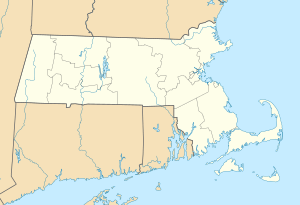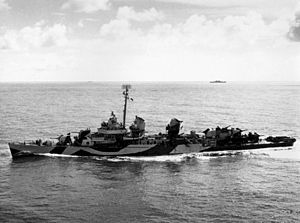USS Cassin Young facts for kids
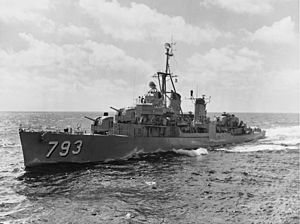
USS Cassin Young underway on 14 January 1958
|
|
| History | |
|---|---|
| Name | Cassin Young |
| Namesake | Cassin Young |
| Builder | Bethlehem Shipbuilding |
| Laid down | 18 March 1943 |
| Launched | 12 September 1943 |
| Sponsored by | Mrs. Eleanor Young |
| Commissioned | 31 December 1943 |
| Decommissioned | 28 May 1946 |
| Recommissioned | 8 September 1951 |
| Decommissioned | 29 April 1960 |
| Stricken | 1 December 1974 |
| Identification | |
| Honours and awards |
See Awards |
| Status | Museum ship at the former Boston Navy Yard in Boston, Massachusetts. |
| Badge | 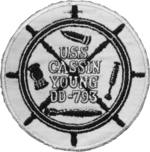 |
| General characteristics | |
| Class and type | Fletcher-class destroyer |
| Displacement | 2,050 tons |
| Length | 376.4 ft (114.7 m) |
| Beam | 39.6 ft (12.1 m) |
| Draft | 13.8 ft (4.2 m) |
| Propulsion |
|
| Speed | 36.5 knots (67.6 km/h; 42.0 mph) |
| Range | 6,500 nmi (12,000 km; 7,500 mi) at 15 knots (28 km/h; 17 mph) |
| Complement | 325 |
| Armament |
|
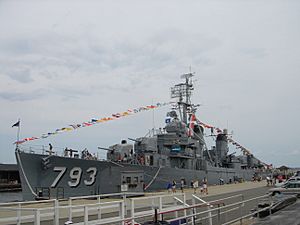 |
|
| Location | Charlestown Navy Yard, Boston, Massachusetts |
| Built | 1943 |
| Architect | Bethlehem Steel Corp. |
| NRHP reference No. | 86000084 |
| Added to NRHP | 14 January 1986 |
The USS Cassin Young (DD-793) is a famous Fletcher-class warship from the United States Navy. It's named after Cassin Young, a brave Captain who earned the Medal of Honor for his courage during the Japanese attack on Pearl Harbor. Sadly, he was killed in battle in 1942.
This ship was built by Bethlehem Shipbuilding and launched on September 12, 1943. It was officially put into service on December 31, 1943.
After serving in World War II, including major battles like the Battle of Leyte Gulf and the Battle of Okinawa, Cassin Young was taken out of service. However, it was brought back during the Korean War and stayed active until 1960. Today, the ship is a memorial ship docked at the Boston Navy Yard in Massachusetts. It sits across from the famous USS Constitution. In 1986, it was named a National Historic Landmark. This is because it is one of only four Fletcher-class destroyers still floating.
You can visit the USS Cassin Young for free at the Boston Navy Yard, which is part of the Boston National Historical Park.
Contents
The Cassin Young in World War II
Joining the Fight in 1944
The Cassin Young arrived at Pearl Harbor in March 1944 to finish its training. Soon after, it joined a huge group of ships called the Fast Carrier Task Force. This powerful force launched air attacks on Japanese bases. The Cassin Young acted as a picket ship, watching for enemy planes and warning other ships.
Later, the ship helped with the invasion of Saipan in June. It provided fire support from the shore and protected escort carriers. These carriers launched planes to attack nearby Japanese airfields. The Cassin Young continued to support invasions of Tinian and Guam until August.
From August to October 1944, the Cassin Young protected carriers as their planes attacked targets in the Philippines. These attacks helped prepare for the invasion of the Philippines. In October, the ship was part of air strikes on Okinawa, Luzon, and Taiwan. During a big air battle, the cruiser Reno was hit by a kamikaze plane. The Cassin Young helped shoot down several enemy aircraft during this attack.
On October 18, 1944, the ship's group prepared for the Battle of Leyte. Two days later, the invasion of Leyte began. The Cassin Young was ready to help if needed. On October 24, a Japanese bomb hit the aircraft carrier Princeton. The Cassin Young then joined other ships to attack the Japanese fleet. This led to the Battle off Cape Engaño, where four Japanese carriers were sunk.
Battles of 1945
The Cassin Young continued to support the fight for Leyte. Its carriers attacked enemy bases on Okinawa, Taiwan, and Luzon. In January 1945, the destroyer protected carriers during raids in the South China Sea. Their planes hit targets in Taiwan, Luzon, Hong Kong, and other areas. This helped with the invasion of Luzon. After some repairs, the ship supported the Battle of Iwo Jima in February. It helped with air strikes and protected ships during the initial attack.
The Okinawa Invasion
The Cassin Young then joined Task Force 54 for the Battle of Okinawa. This was a huge invasion that started on March 22, 1945. The ship helped bombard the island before the invasion. It also supported underwater demolition teams preparing the beaches. On April 1, the invasion day, the destroyer provided fire support. Then, it took on radar picket duty, watching for enemy planes.
During this battle, the Japanese used many kamikaze attacks. On April 6, the Cassin Young faced its first kamikaze action. It rescued survivors from two nearby destroyers that were sunk.
Kamikaze Attacks and Damage
On April 12, a large group of kamikazes attacked. The Cassin Young's guns shot down five planes. But a sixth plane crashed into its front mast, exploding about 50 feet from the ship. Only one sailor, Robert Dean Moore, was killed, but 58 were wounded. Even with damage, the Cassin Young made it to Kerama Retto for repairs. After more repairs, it returned to Okinawa on May 31 for radar picket duty.
The kamikaze attacks continued. On July 28, the Cassin Young's group was attacked again. One destroyer was sunk, and another was badly damaged. The Cassin Young helped shoot down two enemy planes and rescued survivors. At 2:00 AM on July 30, the ship was hit a second time. A low-flying plane struck its right side, hitting the fire control room. A huge explosion and fire followed. But the crew quickly got the fire under control and restored power to one engine. Within 20 minutes, the ship was moving towards safety. Twenty-two men were killed, and 45 were wounded. For its bravery during these attacks, the Cassin Young received the Navy Unit Commendation.
Returning Home and Later Service
The Cassin Young left Okinawa on August 8 and headed home for repairs. After being fully repaired in San Pedro, California, it was taken out of service and placed in reserve on May 28, 1946.
Reactivated for the Korean War
The ship was brought back into service on September 8, 1951. It moved to its new home port in Newport, Rhode Island. In September 1952, it went into dry dock in the Boston Navy Yard for major upgrades. Its weapons were updated, and new radar systems were added.
From 1953 to 1960, the Cassin Young took part in many training exercises. It also served with the 6th Fleet in the Mediterranean Sea several times. In 1954, it went on a round-the-world cruise, visiting ports in Asia and the Mediterranean. During its last overseas trip in 1958, a problem with its rudder was found. The cost to fix it was too high for an older ship. So, on February 6, 1960, it arrived at Norfolk Naval Shipyard to be taken out of service again. The ship was then stored in Philadelphia on April 29, 1960.
A Museum Ship Today
The Cassin Young was officially removed from the Navy's list of ships on December 1, 1974. The US Navy then loaned it to the National Park Service. The ship is now a floating memorial at the Boston Navy Yard, part of the Boston National Historical Park. It arrived on June 15, 1978, and opened to the public in 1981. Volunteers and the National Park Service maintain the ship. In 1986, it was recognized as a National Historic Landmark.
In July 2010, the Cassin Young closed for repairs. On August 9, 2010, it moved into a historic dry dock for the first time in 30 years to fix its hull. After more repairs, it returned to its pier in May 2013. It moved again briefly for berth repairs but was back at its museum spot by September 2013.
Three other Fletcher-class ships are also preserved as memorials:
- USS The Sullivans (DD-537) in Buffalo, New York
- USS Kidd (DD-661) in Baton Rouge, Louisiana
- Greek destroyer Velos (D16), which was once the USS Charrette (DD-581), in Thessaloniki, Greece
Awards and Honors
The Cassin Young earned many awards for its service:
- Navy Unit Commendation
- Asiatic–Pacific Campaign Medal with seven battle stars
- World War II Victory Medal
- Navy Occupation Medal with "EUROPE" clasp
- China Service Medal
- National Defense Service Medal
- Korean Service Medal
- Philippine Presidential Unit Citation
- Korean Presidential Unit Citation
- Philippine Liberation Medal with two stars
- United Nations Service Medal
- Korean War Service Medal
Images for kids
See also


